“Hello, I am shopping for an Oval diamond to propose to my girlfriend. Partly based on reading your Oval Cut Diamond Buying Guide which is great by the way! I was able to narrow the options from Ritani. But I would like your advice on which diamond provides the best value. The setting will either be Ritani’s white gold french set halo (pictured left) or micro pavé halo (pictured below).”
“The diamonds I am looking at are between 1.00 – 1.30 carats (referenced below) and as you can see my budget is $6000 – $7500.00 and I’m looking for the most beautiful diamond possible! Any suggestions or advice would be greatly appreciated! Regards – Ben”
“P.S. Do you have any opinion on 14K white gold vs. 18K white gold? Is there any difference in looks or wear and tear? Would you recommend a different metal?
Ritani Micropave Diamond Engagement Ring Review:
 Thank you for your inquiry. The French Halo setting from Ritani is beautiful and will look amazing set with an oval brilliant-cut diamond! Is this the Micropave Halo that you are referring to? I haven’t seen it in person, but the concept is similar to the French Halo setting from Ritani, and the quality should be comparable, so it should also be an excellent choice.
Thank you for your inquiry. The French Halo setting from Ritani is beautiful and will look amazing set with an oval brilliant-cut diamond! Is this the Micropave Halo that you are referring to? I haven’t seen it in person, but the concept is similar to the French Halo setting from Ritani, and the quality should be comparable, so it should also be an excellent choice.
The primary difference between the two rings appears to be the presence of a small rim of metal positioned on the outside edges of the ring, which might serve to provide some protection for the prongs which hold the accent diamonds in place, and there is a minor difference in the prong structure of the two rings.
French set diamonds vs Micropave set diamonds:
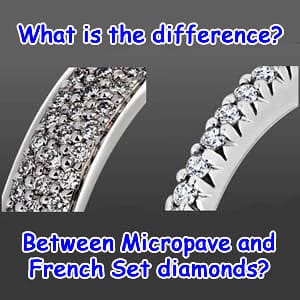 French-set diamonds are set closely together with the prongs set closer together in the middle area that separates each diamond, so that the exposed edges of the diamond are exposed.
French-set diamonds are set closely together with the prongs set closer together in the middle area that separates each diamond, so that the exposed edges of the diamond are exposed.
Supposedly this is done to that more light is able to enter the diamond, thereby creating more sparkle, but in reality, it is nothing more than a different style of setting the diamond.
If you think about it logically, the tips of four prongs are going to cover the same space on the surface of the diamond, regardless of whether they are positioned on the four corners of the diamond, or positioned two by two along the adjoining edges of the diamond as indicated by the ring featured on the right side of the graphic.
While the volume of light that enters a diamond certainly contributes to the volume of light return and brightness of a diamond, the “sparkle” is primarily dictated by the proportions of the diamond, and the degree of optical symmetry, hence the overall cut quality of the diamond has significantly more to do with the “sparkle factor” than the position of the prongs.
Micropavé set diamonds are held in place by prongs which are created by the jeweler using a small, sharp tool to dig metal up from the band and push it up over the diamonds to hold them in place. This style of setting diamonds is referred to as pavé set because the small points of metal, combined with accent diamonds which are small in size, create a look that looks like a street which is paved with cobblestones, as is represented by the ring positioned on the left side of the graphic featured above. The term micropavé is used by the industry to describe the process of pavé setting smaller diamonds, with smaller prongs.
How to select the best oval cut diamonds from Ritani:
It looks like you’ve made some great choices from the Ritani inventory of oval cut diamonds! I’m glad to see that the chart provided in the article that discusses The Best Proportions for Oval Cut Diamonds is helpful to people who are trying to select the best oval cut diamonds online.
I can see by the diamonds which you selected, that you set the recommended range of total depth between 59 – 63% with a table diameter between 55 – 61%, but I would also recommend setting the Cut category to Very Good, and the limits for polish and symmetry to be VG / EX to limit the options to those which are likely to exhibit higher volumes of light return and better sparkle factor. Click here to search for oval cut diamonds on Ritani.
Choosing an oval brilliant cut diamond from Ritani by the numbers:
Let’s look at the parameters for the oval brilliant cut diamonds that you referenced from Ritani in the email which you sent me, along with one or two others that I found when I conducted my search for oval cut diamonds on Ritani using my preferred parameters, which is based upon the information contained in my article The Best Proportions for Oval Cut Diamonds.
Hint: you can search for oval cut diamonds on Ritani using the link provided above and all the advanced parameters will be set for you, then all you have to do is adjust the range of carat weight, color, clarity, and price to fit your preferences when shopping for an oval cut diamond online! All right, in order of carat weight…
Ritani oval cut diamond review: GIA 1159380026
The 1.01 carat, D-color, VVS-2 clarity, oval diamond from Ritani measures 7.56 mm in length x 5.82 mm in width, divide the length/width and you get a length to width ratio of 1.30:1.00 which is a little on the squattier side, but I really like how the bow tie effect appears to be pretty minimal, and the 56% table diameter / 59.7% total depth combination provides a lot of promise.
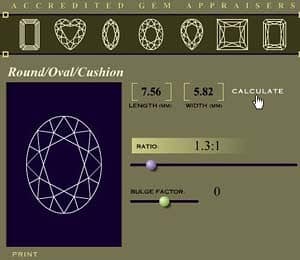 By the way, while it’s pretty easy for me to visualize what an oval brilliant cut diamond with a length to width ratio of 1.30:1.00 is going to look like since I’ve worked as a diamond buyer for almost 30 years.
By the way, while it’s pretty easy for me to visualize what an oval brilliant cut diamond with a length to width ratio of 1.30:1.00 is going to look like since I’ve worked as a diamond buyer for almost 30 years.
It can be challenging for most people to know what the outline of a fancy shape diamond is going to look like based upon the dimensions. This is why I recommend using the Diamond Shape Selector Tool by David Atlas.
The program will calculate the length to width ratio of the diamond, and provide you with a visual representation of what the outline of the diamond will look like.
It is extremely easy to use the diamond shape selector tool designed by David Atlas, simply click on the appropriate diamond shape pictured at the top of the tool, then enter the measurements for the length and width, then click your mouse on the word Calculate, the program will calculate the length to width ratio (length divided by width) and create an outline of the diamond shape for your reference.
In case you’re wondering, the faint blue fluorescence is primarily an identifying characteristic and will have no perceptible effect upon the diamond. And the comment referring to “surface graining not shown” simply means that the diamond grader who graded the diamond, was able to detect some of the grain lines of the crystal while examining the diamond, probably at a level of magnification like 30-40x so you’ll probably never see it. The primary inclusions are “pinpoints” which are simply diamond crystals which are the size of a pinpoint, they’ll be pretty difficult for most people to locate using 10x magnification in a VVS-2 clarity diamond.
Ritani oval cut diamond review: GIA 14754277
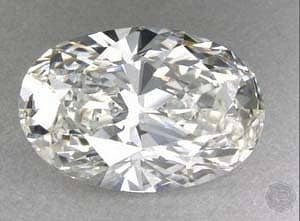 The length to width ratio of the 1.06 carat, G-color, Internally Flawless, oval diamond from Ritani is 1.49:1.00 which looks more like an oval shape to me, and the bowtie effect appears to be minimal, as visible in the picture to the left and the video of the diamond provided on the diamond details page.
The length to width ratio of the 1.06 carat, G-color, Internally Flawless, oval diamond from Ritani is 1.49:1.00 which looks more like an oval shape to me, and the bowtie effect appears to be minimal, as visible in the picture to the left and the video of the diamond provided on the diamond details page.
However, I’m not a fan of the good symmetry rating because it indicates that the diamond lacks symmetry of facet shape and alignment in terms of how the facet junctions meet at the points.
While I have seen very few oval brilliant cut diamonds over the years with a meet point symmetry grade of GIA Excellent, there are usually quite a few available with a symmetry rating of GIA Very Good, and I don’t see a good reason to accept anything less than that because the variances in facet shape and point-to-point alignment that warrants a symmetry rating of GIA Good can result in a loss of light return.
And while the range of proportions referenced in my article The Best Proportions for Oval Cut Diamonds allows for a minimum girdle thickness of very good, it really helps to know where along the girdle edge it becomes very thin, because a very thin girdle edge can be prone to be chipped and damaged.
By the way, the comment “minor details of polish not shown” that appears under the Comments section on the diamond grading report issued by the GIA for this diamond, is a “CYA” type of catch-all statement that appears on all diamond grading reports issued for diamonds graded as being Internally Flawless in clarity, thus it is nothing to be concerned about.
Ritani oval cut diamond review: GIA 16776574
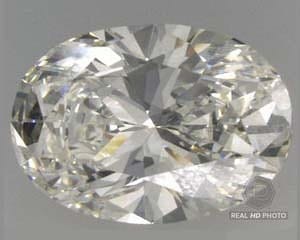 I definitely like the look of the 1.15 carat, G-color, IF clarity, oval diamond from Ritani, and I’m a fan of diamonds with medium to strong blue fluorescence, so this one looks promising! It has a length to width ratio of 1.44:1.00 which looks great, as you can see by the picture to the left.
I definitely like the look of the 1.15 carat, G-color, IF clarity, oval diamond from Ritani, and I’m a fan of diamonds with medium to strong blue fluorescence, so this one looks promising! It has a length to width ratio of 1.44:1.00 which looks great, as you can see by the picture to the left.
The very good / very good polish and symmetry rating is fine for an oval brilliant because the facet structure is not symmetrical like a round brilliant, and thus the light is already traveling in different directions and the difference won’t be quite as noticeable.
Ritani oval cut diamond review: GIA 11428224
I realize that the total depth and table measurements of this 1.23 carat, H-color, IF clarity, oval diamond from Ritani fall within the range specified within The Best Proportions for Oval Cut Diamonds article, but this diamond has a total depth of 56.4% with a table diameter of 58% and I usually avoid fancy shape diamonds (graded by the GIA) where the table diameter is larger than the total depth because there is no way to determine whether the larger table diameter is creating a crown angle which is too shallow.
Unfortunately, the GIA does not provide crown and pavilion measurements on the diamond grading reports they issue for fancy shape diamonds (the AGSL does) and thus the only way to obtain them is to ask Ritani for a manufacturers Sarin | OGI | or Helium, computerized proportions analysis to obtain those measurements… However I’ve yet to have a single client be successful in obtaining a Sarin report from Ritani for a fancy shape diamond because they indicate that their machine is set up to only measure round brilliant cut diamonds.
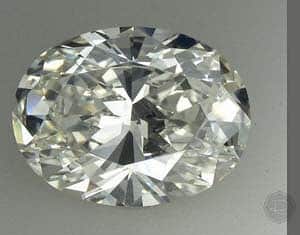 However, this might be a moot point, because if you manage to pause the video of the diamond on just the right frame, it actually looks like the crown height of the diamond is kind of deep and the crown angle is kind of steep.
However, this might be a moot point, because if you manage to pause the video of the diamond on just the right frame, it actually looks like the crown height of the diamond is kind of deep and the crown angle is kind of steep.
Of course, it’s difficult to visually estimate the crown height and crown angle of a diamond off of a single frame captured off a video, so if the diamond were truly of interest I would insist that Ritani provide me with a Sarin computerized proportions analysis. However, I’m generally not a fan of white diamonds with only good symmetry.
Another minor concern is the presence of very strong blue fluorescence because it has the “potential” to create adverse conditions in the visual properties of the diamond, such as making it appear to look cloudy or slightly hazy; especially when the diamond is viewed in direct sunlight where the strong ultraviolet light will excite the blue fluorescent molecules and essentially active them… on a positive note, very strong blue fluorescence can give the diamond a slight lavender-blue hue which can be quite pretty! Plus the very strong blue fluorescence can help to filter out any hint of yellow which might be present in the diamond, which won’t actually be much in an H-color diamond.
Note that according to a study conducted by the GIA Gem Trade Laboratory in 1997 on the effect of fluorescence upon gem-quality diamonds, it is estimated that fewer than 2% are negatively impacted by the presence of blue fluorescence, but most of those are in the range of very strong to distinct blue. Thus before buying this diamond, I would ask the gemologist at Ritani to take it for a walk in a variety of lighting conditions, including direct sunlight, and determine the extent to which the fluorescence is impacting the visual properties of the diamond.
I want to mention that I’m not opposed to diamonds with very strong blue fluorescence or even those with distinct blue fluorescence, the 2.25 carat, I-color, SI-2 clarity, super ideal cut diamond which I selected for my own wedding ring, exhibited very strong blue fluorescence; and if you knew what to look for, the fluorescence did give the diamond a slight lavender-blue appearance when it was exposed to direct sunlight, but it did not appear cloudy at all. However, the 2.53 carat, D-color marquise diamond which my late wife Robin wore, which exhibited distinct blue fluorescence did look a little hazy from time to time… she didn’t mind it, because she loved the effect that fluorescence had upon the diamond, so this is all a matter of personal preference and must be considered individually from diamond-to-diamond.
Ritani oval cut diamond review: GIA 2166336638
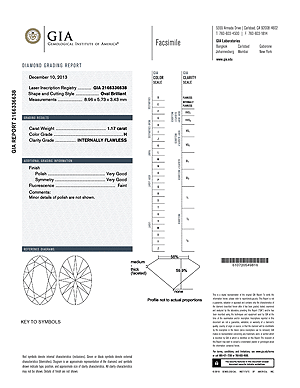 There is one more diamond that I’d like to throw into the mix, which is this 1.17 carat, H-color, IF clarity, oval diamond from Ritani, which has a length to width ratio of 1.56:1.00 and a total depth of 59.9% with a table diameter of 58% with a medium to thick, faceted girdle and no culet with very good polish and symmetry.
There is one more diamond that I’d like to throw into the mix, which is this 1.17 carat, H-color, IF clarity, oval diamond from Ritani, which has a length to width ratio of 1.56:1.00 and a total depth of 59.9% with a table diameter of 58% with a medium to thick, faceted girdle and no culet with very good polish and symmetry.
The total depth, table diameter, and girdle thickness of this diamond are all well within the preferred range of proportions for an oval cut diamond. The diamond seems to exhibit a very nice degree of sparkle in the video provided on the diamond details page.
However, the diamond might seem to be a bit darker in appearance than the others we’ve discussed thus far, I think that the overall lighting of this video is lower though and don’t think that the diamond is any less bright than the other diamonds which you are considering. Ritani might reshoot the video upon request.
The best oval cut diamonds from Ritani:
So the following oval brilliant-cut diamonds from Ritani, listed in order of carat weight, are the ones which seem the most interesting to me:
1.06 carat, G-color, Internally Flawless, oval diamond from Ritani
1.15 carat, G-color, IF clarity, oval diamond from Ritani
1.17 carat, H-color, IF clarity, oval diamond from Ritani
All right, so here are some thoughts to help narrow things down a bit… Keep in mind that the accent diamonds used in the rings by Ritani are H-color, so most people will find that a center stone with a color between F-color to I-color looks perfectly fine, because our eyes are naturally drawn to the larger illuminated surface of the center stone.
I imagine that you might be tempted by the larger carat weight presented by the 1.23 carat, H-color, IF clarity, oval diamond from Ritani because it is “larger” but take note of the dimensions which are 8.31 x 6.29 mm, it is going to look a bit squattier like the 1.01 carat which I provided the graphic for which was generated by the Shape Selector Tool.
I think that the 1.17 carat, H-color, IF clarity, oval diamond from Ritani is actually going to look larger than the 1.23 carat, because the length is 8.95 mm and while the width is narrower at 5.73 mm, people tend to perceive size in terms of length more than width as they see the ring presented lengthwise on a finger… so this diamond is actually going to provide the largest looking diamond of the options presented / currently available.
If you found this review of Ritani oval cut diamonds helpful and would like to receive similar assistance with your diamond quest, just drop me a note.
